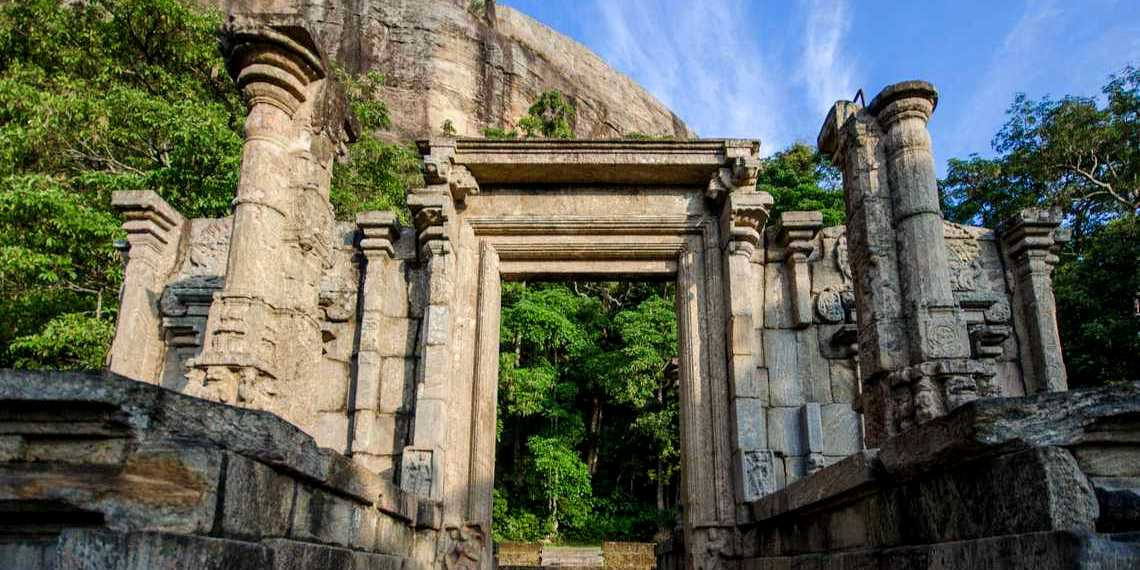Sigiriya Rock Fortress
Sigiriya Rock Fortress, often referred to as the "Eighth Wonder of the World," is a stunning example of ancient urban planning, architecture, and art in Sri Lanka. Situated in the central Matale District near the town of Dambulla, this massive column of rock stands approximately 200 meters (660 ft) high and is visible from miles around in the surrounding jungle.
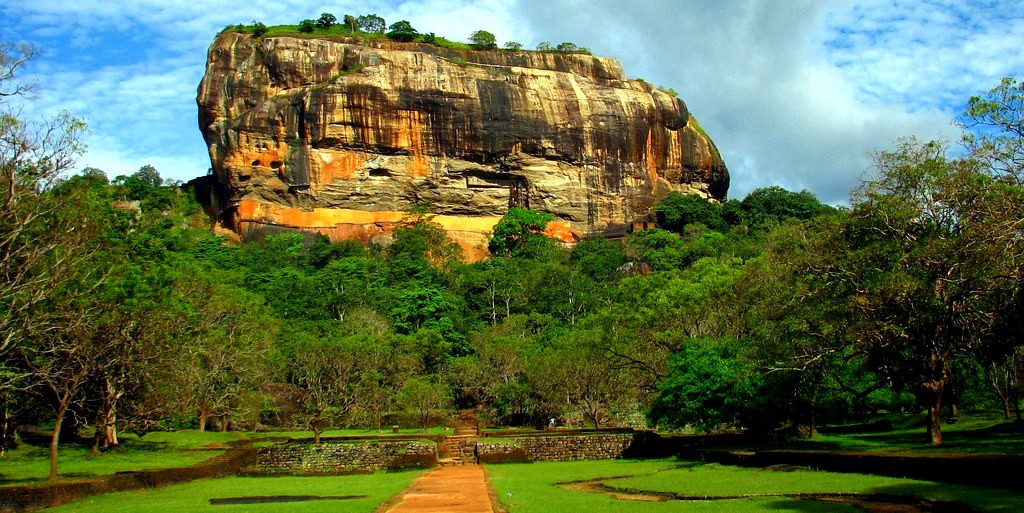
-
Historical Significance: Sigiriya was built during the reign of King Kashyapa (AD 477-495). According to historical records, Kashyapa chose the site for his capital after a power struggle with his brother, converting the massive rock into an impregnable fortress and palace complex. After his death, the site was used as a Buddhist monastery until the 14th century.
-
Architectural Highlights: The approach to the rock fortress is quite dramatic, with gardens that are among the oldest landscaped gardens in the world, divided into water gardens, boulder gardens, and terraced gardens. The water gardens display sophisticated hydraulic technology, with water retaining structures and surface and sub-surface hydraulic systems, some of which work to this day.
-
Artistic Marvels: One of the most remarkable features of Sigiriya is its frescoes, which are similar in style to the paintings seen in the Ajanta Caves of India. These frescoes, which are painted in shelters made into the rock face about halfway up the side of the rock, depict buxom, wasp-waisted women and are considered to be portraits of the ladies of Kashyapa’s court or celestial nymphs.
-
The Mirror Wall: Originally this wall was so well polished that the king could see himself whilst he walked alongside it. Made of a type of porcelain, the wall is now partially covered with verses scribbled by visitors to the rock. Some of them are over a thousand years old and are now a significant aspect of the site's allure, providing insights into the thoughts of ancient visitors.
-
The Lion Gate and Summit: The final ascent to the summit passes through the Lion Gate, named for the huge lion paws carved into the bedrock. The gate leads to the remains of the palace and offers panoramic views of the surrounding jungle and farmland.
-
Modern Day and UNESCO Recognition: Sigiriya is a UNESCO World Heritage Site and is considered one of the best-preserved examples of ancient urban planning. It is one of the most visited tourist destinations in Sri Lanka and a proud symbol of the country's rich cultural heritage.
Visiting Sigiriya Rock Fortress not only allows travelers to step back into Sri Lanka's fascinating history but also offers a chance to experience some of the most inventive and inspired creations of the ancient world.
Anuradhapura Sacred City
Anuradhapura, one of Sri Lanka's ancient capitals, is a city steeped in both historical significance and spiritual sanctity. It served as the center of Theravada Buddhism for many centuries and remains a vital pilgrimage site to this day. Listed as a UNESCO World Heritage Site, Anuradhapura showcases some of the most significant archaeological and architectural wonders in Sri Lanka, reflecting the grandeur of the island's early civilizations.
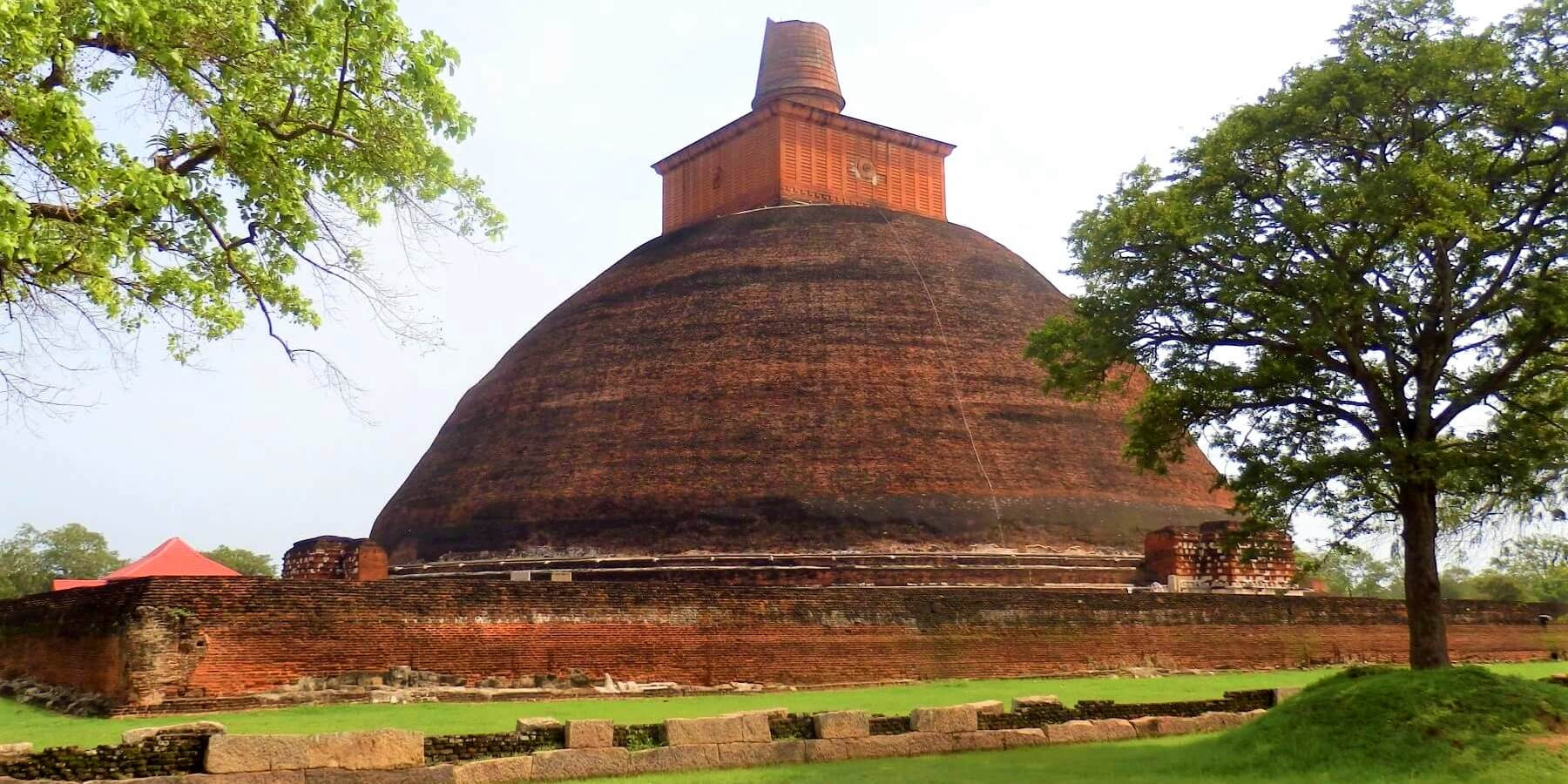
-
Historical Background: Founded in the 4th century BC, Anuradhapura became the political and religious capital of the Sinhalese civilization. It flourished for 1,300 years until invasions led to its abandonment. Rediscovered in the 19th century, extensive restoration and excavation have revealed the city’s impressive scale and beauty, which had been hidden in dense jungle.
-
Stupas (Dagobas): The skyline of Anuradhapura is dominated by massive stupas constructed of bricks. Among the most famous are Ruwanwelisaya, Thuparamaya, and Jetavanarama. Ruwanwelisaya, built by King Dutugemunu in the 2nd century BC, is particularly revered, encircled by an elegant procession of elephant sculptures.
-
Sri Maha Bodhi Tree: Perhaps the most sacred of all sites in Anuradhapura is the Sri Maha Bodhi tree, grown from a cutting of the original Bodhi tree under which the Buddha attained enlightenment. It is the oldest living human-planted tree in the world with a known planting date and remains a major pilgrimage site during the Poson Poya (full moon) in June, celebrating the arrival of Buddhism in Sri Lanka.
-
Ancient Pools: The Twin Ponds (Kuttam Pokuna) and other ancient pools showcase the sophisticated hydraulic engineering of the Anuradhapura period, designed for the use of monks at the nearby Abhayagiri Monastery.
-
Cultural Significance: The city's extensive monastic complexes, including the Abhayagiri Vihara, Dakkhina Stupa, and the Lankarama, were once home to thousands of monks. These complexes contain rich archaeological remains that illustrate a blend of religious and secular life.
-
Conservation and Tourism: Today, Anuradhapura is a site of ongoing archaeological importance as well as a living city. Conservation efforts focus on preserving both the ruins and the religious traditions that are still alive. The city is an essential part of the Cultural Triangle of Sri Lanka, which aims to promote the preservation and understanding of the island’s rich heritage.
Visiting Anuradhapura offers a profound glimpse into the ancient past of Sri Lanka, highlighting the deep spiritual roots and architectural prowess that shaped this great civilization. Its serene and sacred atmosphere continues to draw both pilgrims and tourists, eager to explore one of the cradles of Buddhism and a cornerstone of Sri Lankan culture.
Polonnaruwa Archaeological Site
Polonnaruwa Archaeological Site, recognized as a UNESCO World Heritage Site, represents the second capital of Sri Lanka after the destruction of Anuradhapura in 993. Flourishing in the 10th to the 12th centuries AD, Polonnaruwa showcases the ancient city's transition from a monastic center to a royal capital, renowned for its sophisticated planning and intricate architectural elements. This city is a testament to the discipline and grandeur of Medieval Sri Lanka and remains an essential stop for those exploring the country's rich history.
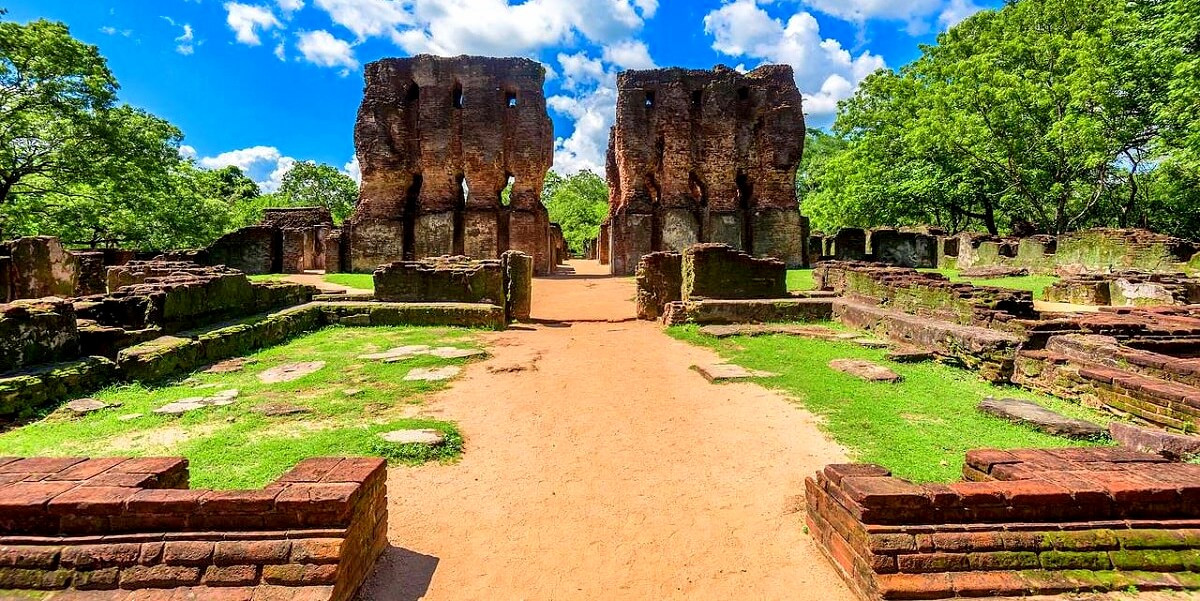
-
Historical Context: After the fall of Anuradhapura, King Vijayabahu I moved the capital to Polonnaruwa, a strategic move that shielded the seat of governance from southern Indian invaders. Under kings Parakramabahu I and Nissankamalla, Polonnaruwa reached the zenith of its architectural and hydrological development, becoming a cosmopolitan center of trade and Buddhism.
-
Gal Vihara: This monument is perhaps the most iconic feature of Polonnaruwa, consisting of a series of large Buddha statues carved out of a granite cliff. The images, which include a massive reclining Buddha measuring 14 meters in length, reflect the skill and creativity of Sinhalese sculptors.
-
The Royal Palace: The remains of the seven-story Royal Palace built by King Parakramabahu I indicate the luxurious lifestyle of the Sinhalese monarchy. The palace was said to have had a thousand rooms, and although only a few walls and foundations remain, they give an impression of the structure's original grandeur.
-
The Quadrangle (Dalada Maluwa): This compact area contains some of the oldest and most sacred monuments in Polonnaruwa, including the Vatadage, which may have housed the Sacred Tooth Relic of the Buddha. The circular structure with delicately carved stone pillars and stupas is an architectural marvel.
-
Rankoth Vehera: This is the largest stupa in Polonnaruwa and the fourth largest on the island. Built by King Nissankamalla, it resembles the Ruwanwelisaya in Anuradhapura and is an excellent example of Buddhist stupa design.
-
Cultural and Educational Significance: Polonnaruwa provides a window into the advanced urban planning and the hydraulic civilization of medieval Sri Lanka. The Parakrama Samudra, a giant reservoir built by King Parakramabahu I, is a feat of ancient engineering that still provides irrigation water to the surrounding fields today.
-
Conservation Efforts: Ongoing preservation efforts by both local and international teams aim to maintain the structural integrity and historical accuracy of Polonnaruwa's sites. Educational programs and visitor centers help tourists understand the city's historical and cultural importance, ensuring that this ancient city continues to inform and inspire future generations.
-
Visiting Polonnaruwa: For visitors, Polonnaruwa offers a more compact and accessible experience than Anuradhapura, with many of its ruins located within walking distance of each other. The site is an essential component of Sri Lanka's Cultural Triangle, and its well-preserved monuments and relics continue to attract scholars, history enthusiasts, and tourists from around the world.
Exploring Polonnaruwa is not only a journey back in time but also an opportunity to witness the enduring legacy of Sri Lanka’s rich history, making it a must-visit destination for anyone interested in the island's past.
Temple of the Tooth (Sri Dalada Maligawa) in Kandy
The Temple of the Tooth, or Sri Dalada Maligawa, in Kandy is one of the most sacred Buddhist sites in Sri Lanka and a pivotal symbol of Sri Lankan identity and spirituality. This temple houses the sacred tooth relic of the Buddha, making it a major religious site not only for Sri Lankans but for Buddhists from around the world. It is also a UNESCO World Heritage Site, recognized for its cultural and historical significance.
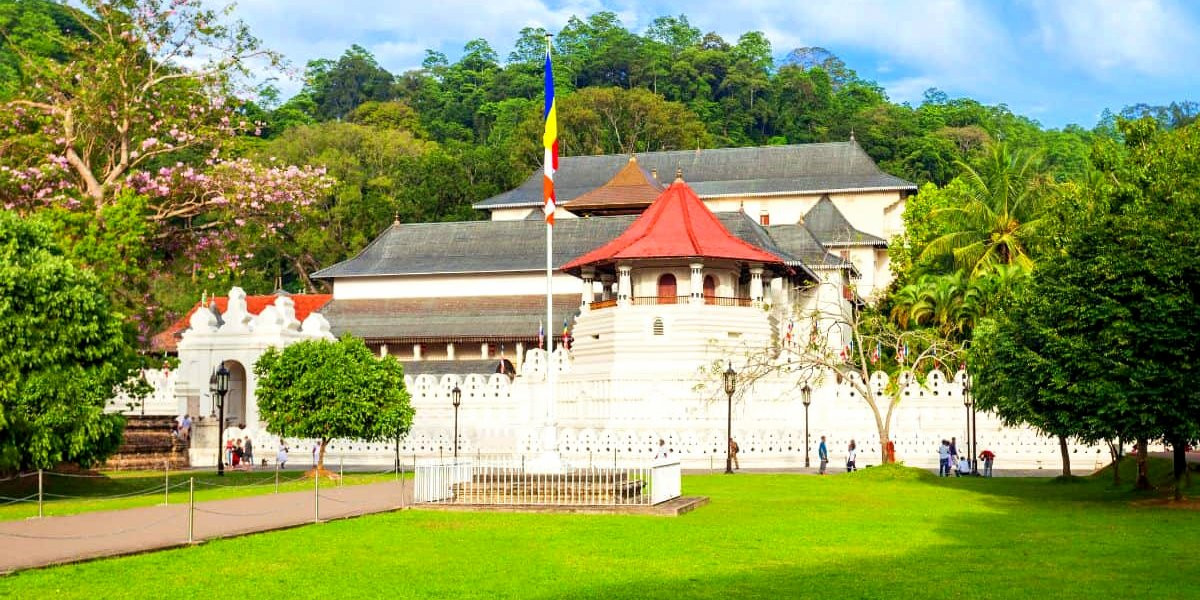
-
Historical Background: The Temple of the Tooth was built in the 16th century by the Kandyan kings, who ruled over the central highlands of Sri Lanka. The tooth relic has played an important role in local politics since ancient times, as it is believed that whoever holds the relic holds the governance of the country. Therefore, the temple was constructed within the royal palace complex of the Kandyan kingdom, which served as the last capital of the independent Sinhalese kingdom before falling to colonial rule.
-
Architectural Significance: The architecture of the Temple of the Tooth is an outstanding example of Kandyan architecture, with its red roofs, white walls, and intricately carved woodwork. The complex consists of numerous buildings adorned with paintings and carvings that depict important moments in Buddha's life and significant historical events in the history of the temple.
-
Rituals and Ceremonies: The temple is known for the daily pujas (offerings or prayers), which occur three times a day. During these times, the room housing the tooth relic is opened to devotees and tourists, who offer flowers and prayers. The most elaborate ceremony is the weekly Wednesday ceremony, known as Nanumura Mangallaya, during which the relic casket is ritually cleansed with scented water.
-
Esala Perahera Festival: One of the highlights of the temple's calendar is the Esala Perahera, a grand festival held annually in July or August. This spectacular event includes a series of processions over ten nights, featuring dancers, drummers, and elegantly decorated elephants. It culminates in a grand parade where the tooth relic is carried through the streets of Kandy in a golden casket on the back of a majestic elephant, showcasing a blend of religious devotion and cultural pageantry.
-
Visiting the Temple: Visitors to the Temple of the Tooth are expected to adhere to strict dress codes, typically covering legs and arms and removing shoes before entering. Inside, they can explore the various halls, view the casket from a distance (as the actual tooth is kept in a gold casket shaped like a stupa and is not displayed), and witness the vibrant daily rituals that are central to the spiritual life of the temple.
The Temple of the Tooth in Kandy is not just a religious site but a living cultural heritage that offers insight into the profound spirituality and historical continuity of Sri Lanka. It remains a must-visit for anyone wanting to understand the depth of Buddhism's influence on the island and experience the enduring legacy of its ancient traditions.
Dambulla Cave Temple
The Dambulla Cave Temple, also known as the Golden Temple of Dambulla, is a remarkable and expansive cave temple complex in Sri Lanka, renowned for its rich historical and artistic significance. Situated in the central part of the island, this site has been a sacred pilgrimage location for 22 centuries and is the largest and best-preserved cave temple complex in Sri Lanka. Recognized as a UNESCO World Heritage Site, Dambulla Cave Temple provides a unique insight into the development of Buddhism in Sri Lanka through its exquisite mural paintings and statues.
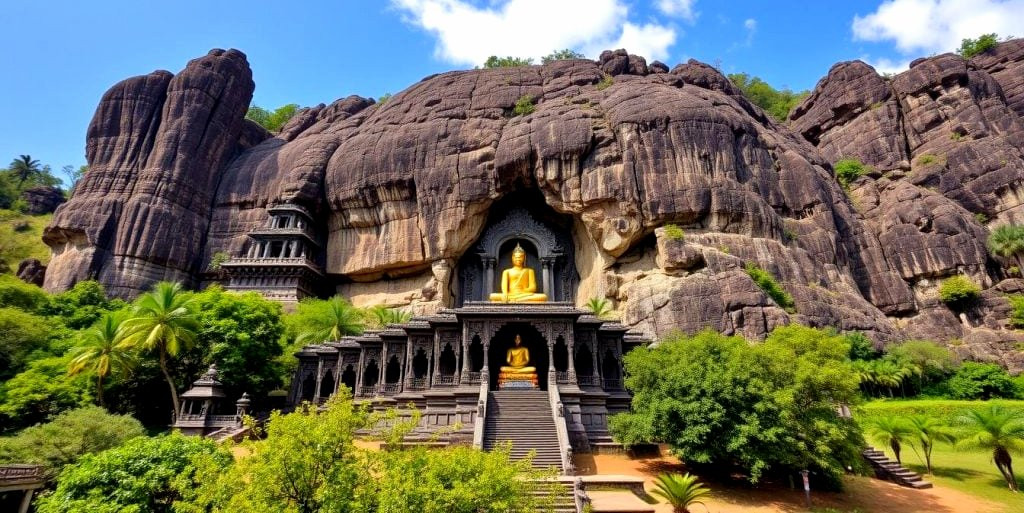
Historical Background: The history of the Dambulla Cave Temple dates back to the 1st century BCE, when King Valagamba (Vattagamini Abhaya) took refuge in these caves during a period of exile from Anuradhapura. After regaining his throne, the king had the interior of the caves carved into magnificent rock temples as a gesture of gratitude to the monks living there. Since then, successive kings have added to and embellished the cave complex, contributing to its grandeur and religious importance.
The Cave Complex
The temple complex consists of five major caves, each filled with statues and paintings predominantly related to Gautama Buddha and his life. Here are the highlights:
-
Cave 1 (Devaraja Viharaya or Temple of the King of Gods) - This cave is dominated by a 14-meter statue of a reclining Buddha, depicting the Buddha's final entry into Nirvana. The cave also contains statues of deities and the historical Buddha images.
-
Cave 2 (Maharaja Viharaya or Temple of the Great Kings) - The largest and most impressive cave, featuring a vast array of Buddha statues in various mudras (gestures) and numerous paintings on the ceilings and walls that depict scenes from the Buddha's life. This cave also houses statues of Sri Lankan kings and gods.
-
Cave 3 (Maha Alut Viharaya or Great New Temple) - Known for its beautiful, relatively modern murals and a large seated Buddha statue, this cave reflects more recent artistic contributions, including those from the Kandyan era.
-
Cave 4 (Pachima Viharaya) - Smaller and less elaborate, this cave contains a reclining Buddha and is adorned with simpler decor.
-
Cave 5 (Devana Alut Viharaya) - The smallest cave, with a collection of seated Buddha statues and is relatively plain compared to the other caves.
Artistic Features: The Dambulla Cave Temple is famed for its wall and ceiling murals, which cover an area of over 2,100 square meters, making it one of the most extensively embellished cave complexes in the world. The artwork depicts Buddha's temptations by demon Mara and his first sermon.
Cultural Significance: Dambulla Cave Temple continues to be an active monastery and is a pivotal example of the continued religious tradition in Sri Lanka. The site illustrates the historical trajectory of Theravada Buddhism on the island and showcases the blending of art and spirituality that characterizes Sri Lankan cultural heritage.
Visiting Dambulla: Visitors to Dambulla are treated not only to a historical and spiritual journey but also to stunning panoramic views of the surrounding plains and the Sigiriya Rock Fortress in the distance. The caves offer a tranquil and introspective experience, reflecting centuries of devotion and artistic achievement.
The Dambulla Cave Temple stands as a testament to the enduring power of religious devotion and the artistic endeavor, making it a must-visit for anyone interested in the history, culture, and spiritual life of Sri Lanka.
Galle Dutch Fort
Galle Dutch Fort, also known simply as Galle Fort, is an exceptionally well-preserved colonial town that has stood the test of time, showcasing the intricate blend of European architecture and South Asian traditions. Located in the bay city of Galle on the southwestern coast of Sri Lanka, the fort is a UNESCO World Heritage Site, recognized for its cultural and historical significance as one of the best examples of a fortified city built by Europeans in South and Southeast Asia.
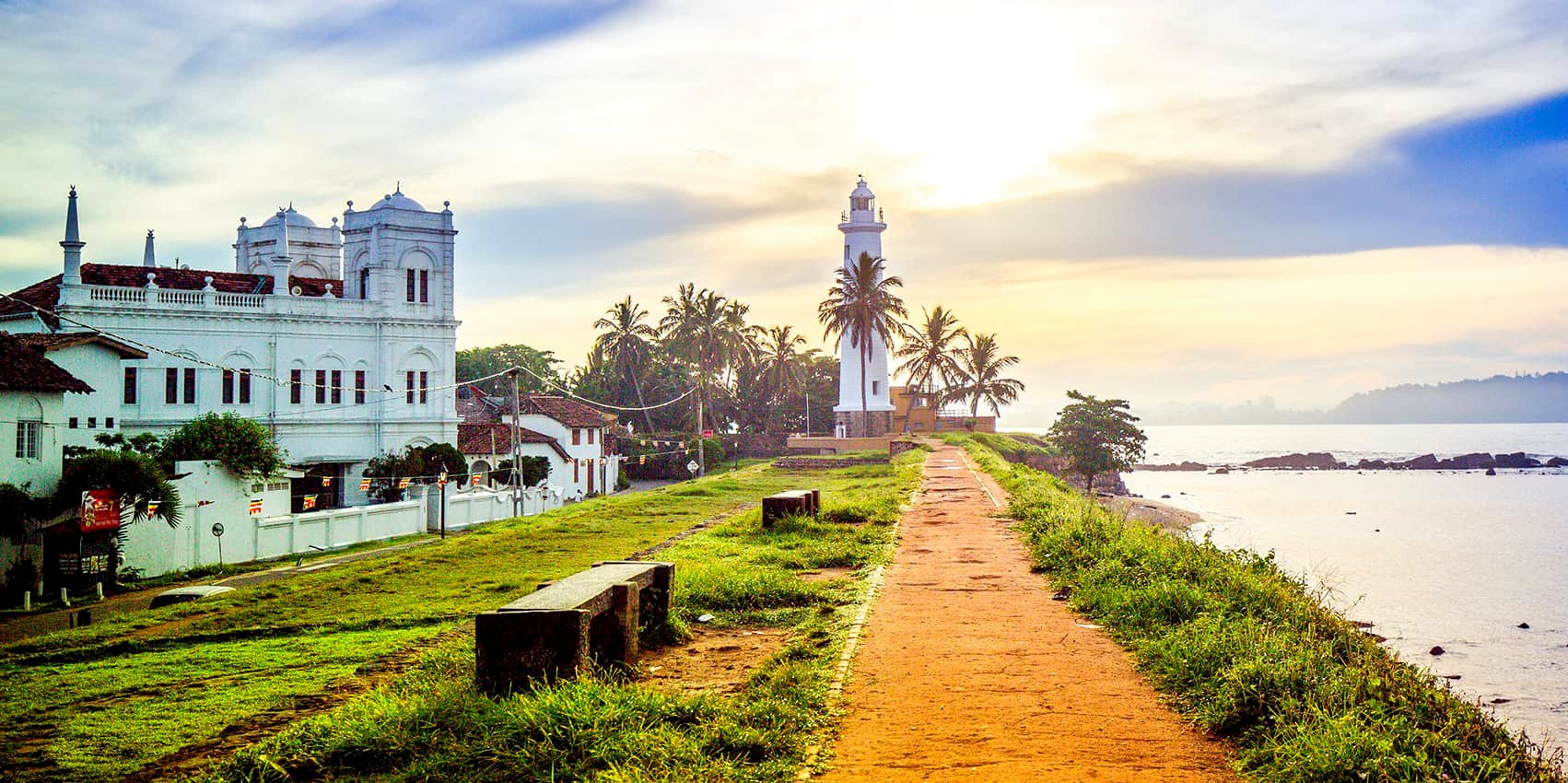
Historical Background: The fort's origins trace back to 1588 when the Portuguese first built a fortification on the site. However, it was extensively expanded and fortified by the Dutch during the 17th century, after they took control of the area from the Portuguese in 1640. The British took over in 1796 and made their own modifications, but the fort's distinctive Dutch character remained largely intact.
Architectural Highlights: The Galle Fort encompasses a walled enclave with a robust grid of streets lined with low houses exhibiting Dutch colonial architecture, churches, and commercial buildings. The fort's walls, constructed from coral and granite, have withstood tsunamis and other natural calamities, particularly the 2004 Indian Ocean tsunami, which devastated other parts of Galle but largely spared the fort.
Key landmarks within the fort include:
-
The Dutch Reformed Church: Built in 1755, this church features floor tiles that were originally gravestones from the Dutch cemetery.
-
The Galle Lighthouse: This is the oldest light station in Sri Lanka, first built in 1848 and standing at the fort’s southeastern tip.
-
The Maritime Museum: Located in a restored Dutch warehouse, it displays marine artifacts that narrate the history of the local area and the influence of maritime trade.
Cultural and Social Fabric: Today, Galle Fort is a vibrant cultural hub, with a diverse community that reflects a mixture of ethnic groups, religions, and cultures. The area is known for its artisanal shops, boutique hotels, cafes, and galleries that inhabit the beautifully restored colonial buildings. Regular cultural events, like literary festivals and art shows, add to the fort’s lively atmosphere.
Preservation and Tourism: Preservation efforts in Galle Fort are rigorous, with strict regulations to maintain its historical integrity while accommodating modern amenities. This balance between preservation and contemporary use makes it a unique example of living history. For visitors, walking through the fort offers a glimpse into the past, with the opportunity to engage directly with the history and culture of the colonial era in a setting that feels both timeless and vibrant.
Galle Dutch Fort is not just an architectural marvel but also a cultural treasure, embodying the layered history of Sri Lanka under European colonial rule. It stands as a testament to the resilience and enduring charm of historical preservation, offering visitors an enchanting journey through time amidst the tranquil backdrop of the Indian Ocean. Whether you are a history enthusiast, an architecture aficionado, or simply in search of a picturesque and culturally rich destination, Galle Fort provides a compelling and enriching experience.
Mihintale
Mihintale is a remarkable mountain peak in Sri Lanka, located near the city of Anuradhapura. It is considered the cradle of Buddhism in Sri Lanka and holds a special place in the heart of many Buddhists as well as historians and cultural enthusiasts. This site is revered not only for its religious significance but also for its historical and archaeological importance.
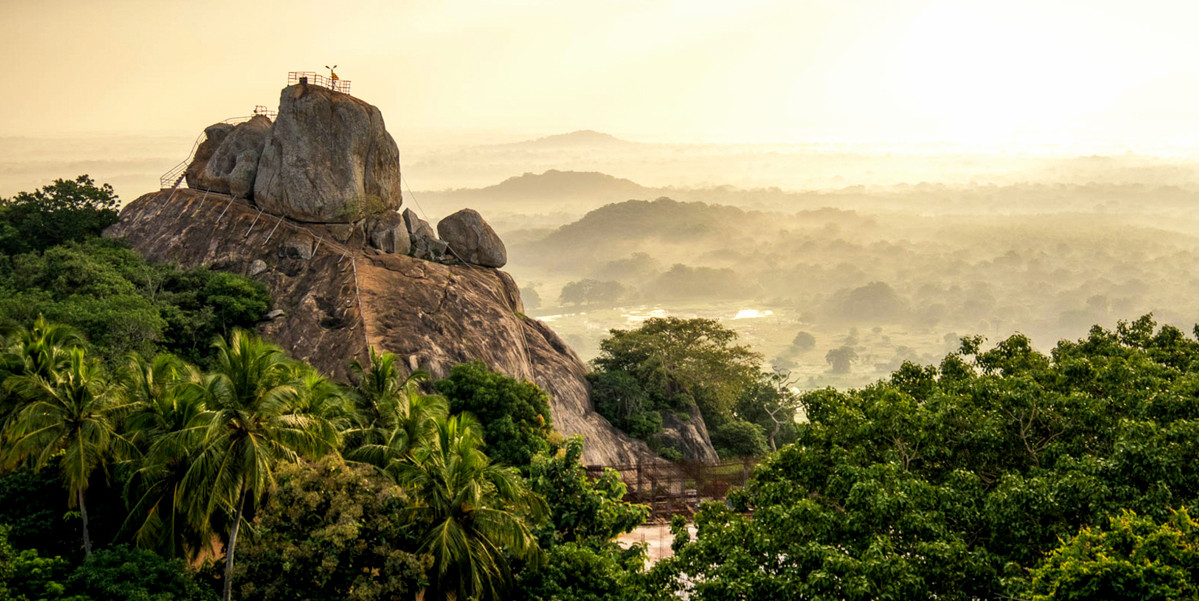
Historical and Religious Significance: The story of Mihintale is closely tied to the introduction of Buddhism to Sri Lanka. According to traditional narratives, it was here in 247 BC that Mahinda, a Buddhist monk and the son of the Indian Emperor Ashoka, met King Devanampiyatissa of Sri Lanka during a hunting expedition. This meeting led to the king's conversion to Buddhism and marked the beginning of Buddhism’s spread across the island. This event is celebrated annually on Poson Poya, a day of great religious significance in Sri Lanka, attracting thousands of pilgrims.
Archaeological and Architectural Highlights
Mihintale is an archaeological treasure trove featuring several important structures and remnants that speak volumes about its past:
-
Kantaka Chetiya: This stupa is one of the earliest in Sri Lanka and is adorned with beautiful friezes and carvings.
-
Ambasthala Dagoba: Situated at the site where Mahinda and King Devanampiyatissa first met, this small stupa is surrounded by stone pillars and a courtyard.
-
Maha Seya: This is the largest stupa in Mihintale, offering panoramic views of the surrounding countryside from its summit.
-
The Aradhana Gala: A large rock that overlooks the surrounding plains, believed to be the spot where Mahinda called out to King Devanampiyatissa. It is a steep climb but considered a pilgrimage in itself.
-
Naga Pokuna (Snake Pond): A man-made pond with a five-headed cobra sculpture carved into the rock face, illustrating the sophisticated hydraulic engineering of ancient Sri Lanka.
Visitor Experience: Mihintale is accessed via a grand stairway of 1,840 granite steps that lead to the summit. The climb, though strenuous, is lined with frangipani trees and offers several spots to rest and admire the scenery. The site is particularly striking during Poson when it is decorated with lanterns and filled with devotees.
Conservation and Tourism: Efforts have been made to preserve the integrity of Mihintale’s historical and religious monuments. The site is maintained by the Archaeological Department of Sri Lanka, which regulates conservation projects and visitor activities to ensure that the site’s sanctity and archaeological value are respected.
Mihintale is a site of profound historical and spiritual significance, offering a unique blend of natural beauty, archaeology, and spirituality. For visitors, it provides a deep insight into the origins of Buddhism in Sri Lanka and the rich cultural tapestry of the ancient Sinhalese civilization. Whether you are a pilgrim, a history buff, or simply a lover of beautiful landscapes, Mihintale offers a memorable and enriching experience.
Rules and Regulations During Historical sites in Sri Lanka
Visiting historical sites in Sri Lanka is a profound experience that offers insights into the island's rich cultural heritage and ancient history. To ensure the preservation of these invaluable sites and to maintain a respectful environment, there are several rules and regulations that visitors are expected to follow:
-
Dress Code: Most religious and historical sites, especially temples like the Temple of the Tooth in Kandy, require visitors to dress modestly. Shoulders and knees should be covered, and hats should be removed when entering sacred areas. It’s advisable to carry a scarf or sarong to cover up appropriately when necessary.
-
Photography Restrictions: While photography is generally allowed at most historical sites, flash photography may be prohibited inside certain areas, particularly in temples where murals and paintings could be damaged by light exposure. Some sites may also restrict photography of certain religious artifacts or areas.
-
Conduct: Behaving respectfully is paramount. Loud conversations, inappropriate behavior, or public displays of affection can be considered disrespectful in these culturally significant spaces. Always follow the guidance of signage and local custodians.
-
Footwear: Shoes must be removed before entering temple complexes and certain other historical buildings. This is a sign of respect and also helps to protect the flooring surfaces of these ancient sites.
-
Entrance Fees: Most historical sites charge an entrance fee, which is used for the maintenance and preservation of these sites. Fees may vary, and often there are different rates for local and foreign visitors.
-
Environmental Considerations: Littering is strictly prohibited to maintain the cleanliness and integrity of the sites. Visitors are encouraged to carry out any trash or dispose of it properly in designated bins.
-
Climbing on Structures: Climbing on or touching ancient structures and statues is usually forbidden to prevent damage. Always adhere to the barriers and paths provided.
-
Smoking and Alcohol: Smoking and the consumption of alcohol are prohibited within the premises of most historical sites to preserve the sanctity and cleanliness of these spaces.
-
Respect for Monuments: Do not deface or mark the monuments in any way. Graffiti and vandalism are illegal and can result in fines or other legal consequences.
-
Guided Tours: In some locations, guided tours may be mandatory or highly recommended to ensure that visitors receive accurate information and do not inadvertently damage sensitive areas.
By adhering to these rules and regulations, visitors can help preserve Sri Lanka's historical sites for future generations while enjoying a meaningful and educational visit.
Exploring the historical sites of Sri Lanka offers a profound journey through the island's rich heritage. From the majestic Sigiriya Rock Fortress to the sacred Temple of the Tooth in Kandy, each site encapsulates the cultural and spiritual legacy of this vibrant nation. These monuments not only highlight architectural marvels but also embody the enduring spirit of the Sri Lankan people. As caretakers of these treasures, both locals and tourists play a crucial role in preserving them for future generations. In essence, Sri Lanka's historical sites provide an unforgettable exploration of history, culture, and timeless significance, making every visit a memorable encounter with the past.
FAQs for Historical sites in Sri Lanka
Q: What are the must-visit historical sites in Sri Lanka?
A: Essential sites include the Sigiriya Rock Fortress, the ancient cities of Anuradhapura and Polonnaruwa, the Temple of the Tooth in Kandy, Dambulla Cave Temple, and the Galle Dutch Fort.
Q: Do I need to pay entrance fees at these historical sites?
A: Yes, entrance fees are typically required and vary by site. These fees contribute to the maintenance and conservation of the sites.
Q: What should I wear when visiting historical and religious sites?
A: Visitors should dress modestly, covering shoulders and knees, and remove shoes when entering sacred areas, particularly temples.
Q: Are there any particular customs I should be aware of when visiting these sites?
A: Respectful behavior is crucial—avoid loud noises and inappropriate actions. Smoking and alcohol are generally prohibited.
Q: Is photography allowed at these sites?
A: Photography is usually permitted, but flash photography and photography in specific restricted areas might be prohibited. Always check signage or ask staff if unsure.
Q: What is the best time of the year to visit these historical sites in Sri Lanka?
A: The ideal visiting time is during the dry season from December to April, which offers more comfortable weather for outdoor activities.
Q: Can I bring food and drinks into these sites?
A: Generally, food and drinks are not allowed inside the historical sites to keep them clean and preserve the sanctity of sacred areas. Some sites may have designated eating areas.
Q: How accessible are these sites for travelers with disabilities?
A: Accessibility varies significantly. Some sites like Galle Dutch Fort are relatively accessible, while others, such as Sigiriya Rock Fortress, may present challenges. It's advisable to research in advance.
Q: Are guided tours available, and would you recommend one?
A: Guided tours are available at most major historical sites and are recommended for a richer, more informative experience. Guides can provide in-depth historical context and share local stories.
Q: What are the opening hours for these sites?
A: Opening hours typically extend from early morning to the evening but can vary by site and season. Check specific times in advance to plan your visit effectively.
For the Nepal tour, please click here.
If you are looking for different kinds of Nepal Tours or Trekking Packages, feel free to contact us.
